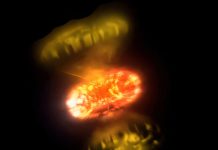
The James Webb Space Telescope (JWST) has given astronomers their clearest look yet at what galaxies looked like when the universe was very young—and the picture is far from peaceful.
Instead of neat, rotating spirals like our Milky Way, the earliest galaxies were wild, turbulent, and “messy,” constantly shifting and colliding as they struggled to take shape.
A team from the University of Cambridge studied more than 250 young galaxies that existed between 800 million and 1.5 billion years after the Big Bang.
Using Webb’s powerful instruments, they examined how gas moved within these distant galaxies and found that most of them were far from stable.
Instead of rotating in an orderly way, their gas swirled in many directions, forming clumpy, uneven structures that looked more like cosmic storms than smooth disks.
The study, published in Monthly Notices of the Royal Astronomical Society, shows that galaxies became calmer and more organized over time.
In the early universe, however, star formation and frequent mergers stirred up so much energy that galaxies couldn’t easily settle into the familiar shapes we see today.
Lead author Lola Danhaive from Cambridge’s Kavli Institute for Cosmology explained that this is the first time scientists have been able to look at such a large population of early galaxies all at once.
“We found huge variation,” she said.
“Some galaxies were starting to settle into ordered rotation, but most were still chaotic, with gas puffed up and moving in all directions.”
The researchers used JWST’s Near-Infrared Camera (NIRCam) in a special “grism mode” that separates light into different wavelengths.
This allowed them to study faint signals from ionized hydrogen gas—the key ingredient for star formation. Danhaive even created new computer code to analyze these data and combine them with Webb’s sharp images, revealing how gas flowed within each galaxy.
Earlier studies, which focused on just a few massive galaxies, had suggested that large, well-formed disks existed surprisingly early in cosmic history.
But this new study tells a different story. By examining hundreds of smaller galaxies, the team showed that most early galaxies were unstable and constantly changing. Co-author Dr. Sandro Tacchella said, “These results fit much better with what our models predict. Early galaxies grew up through mergers and bursts of star formation before becoming the calm, organized systems we see later.”
The findings help bridge a key period in cosmic history, between the “epoch of reionization”—when the first galaxies lit up the universe—and “cosmic noon,” when star formation peaked billions of years later.
“This is just the beginning,” Tacchella added. “With more Webb data, we’ll be able to watch how these messy, turbulent galaxies evolved into the elegant spirals and ellipticals we see in the modern universe.”
Source: University of Cambridge.



